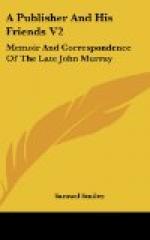JAMES STREET, October 20, 1814.
My DEAR SIR,
What can I say in return for your interesting and amusing letter? I live here quite alone, and see nobody, so that I have not a word of news for you. I delight in your visit to Scotland, which I am sure would turn to good, and which I hope you will, as you say, periodically repeat. It makes me quite happy to find you beating up for recruits, and most ardently do I wish you success. Mention me kindly to Scott, and tell him how much I long to renew our wonted acquaintance. Southey’s article is, I think, excellent. I have softened matters a little. Barrow is hard at work on Flinders [Q. R. 23]. I have still a most melancholy house. My poor housekeeper is going fast. Nothing can save her, and I lend all my care to soften her declining days. She has a physician every second day, and takes a world of medicines, more for their profit than her own, poor thing. She lives on fruit, grapes principally, and a little game, which is the only food she can digest. Guess at my expenses; but I owe in some measure the extension of my feeble life to her care through a long succession of years, and I would cheerfully divide my last farthing with her. I will not trouble you again on this subject, which is a mere concern of my own; but you have been very kind to her, and she is sensible of it.”
With respect to this worthy woman, it may be added that she died on February 6, 1815, carefully waited on to the last by her affectionate master. She was buried in South Audley Churchyard, where Gifford erected a tomb over her, and placed on it a very touching epitaph, concluding with these words: “Her deeply-affected master erected this stone to her memory, as a faithful testimony of her uncommon worth, and of his gratitude, respect, and affection for her long and meritorious services.” [Footnote: It will serve to connect the narrative with one of the famous literary quarrels of the day, if we remind the reader that Hazlitt published a cruel and libellous pamphlet in 1819, entitled “A Letter to William Gifford,” in which he hinted that some improper connection had subsisted between himself and his “frail memorial.” Hazlitt wrote this pamphlet because of a criticism on the “Round Table” in the Quarterly, which Gifford did not write, and of a criticism of Hunt’s “Rimini,” published by Mr. Murray, which was also the work of another writer. But Gifford never took any notice of these libellous attacks upon him. He held that secrecy between himself and the contributors to the Quarterly was absolutely necessary. Hazlitt, in the above pamphlet, also attacks Murray, Croker, Canning, Southey, and others whom he supposed to be connected with the Review.]
Murray’s own description of his famous drawing-room may also be given, from a letter to a relative:




